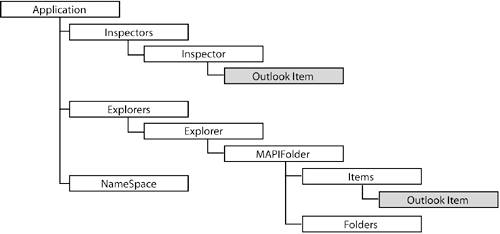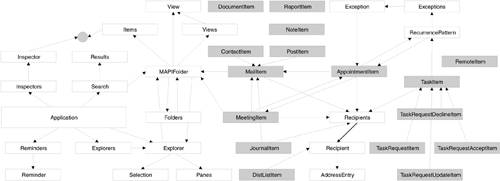Introduction to the Outlook Object Model
Regardless of the approach you choose to integrate your code with Outlook, you will eventually need to talk to the Outlook object model to get things done. This section introduces the Outlook object model; Chapter 10, "Working with Outlook Events," and Chapter 11, "Working with Outlook Objects," describe some of the most frequently used properties, methods, and events. This chapter also briefly examines another object model you can use with Outlook called Collaboration Data Objects (CDO).
The Object Hierarchy of the Outlook Object Model
The first step in starting to learn the Outlook object model is getting an idea for the basic structure of the object model hierarchy. Figure 9-11 shows some of the most critical objects in the Outlook object model and their hierarchical relationship.
Figure 9-11. The basic hierarchy of the Outlook object model.

The Outlook object model has the notion of an Outlook item. An Outlook item is represented in the object model as an object and can be cast to one of 15 different Outlook item types shown in Table 9-1. Some objects in the object model, such as the MAPIFolder object, contain an Items collection that can contain instances of any of the 15 Outlook item typestherefore, the folder may contain a mixture of MailItem objects, TaskRequestItem objects, and so on. When you iterate over a collection of Items, Outlook returns each item to you as an object that you must cast to one of the 15 Outlook item types before using it.
|
Object |
Description |
|---|---|
|
ContactItem |
A contact item typically found in the Contacts folder. |
|
DistListItem |
A distribution list typically found in the Contacts folder. |
|
DocumentItem |
A document that you have added to an Outlook folder by dragging and dropping it from the file system into the Outlook folder. |
|
JournalItem |
A journal entry typically found in the Journal folder. |
|
MailItem |
A mail message typically found in the Inbox folder. |
|
MeetingItem |
A meeting request typically found in the Inbox folder. |
|
NoteItem |
A note typically found in the Notes folder. |
|
PostItem |
A post in an Outlook folder. |
|
RemoteItem |
A mail message that has not yet been fully retrieved from the server but has the subject of the message, the received date and time, the sender, the size of the message, and the first 256 characters of the message body. |
|
ReportItem |
A mail delivery report such as a report when mail delivery failed typically found in the Inbox folder. |
|
TaskItem |
A task typically found in the Tasks folder. |
|
TaskRequestAcceptItem |
A response to a TaskRequestItem typically found in the Inbox folder. |
|
TaskRequestDeclineItem |
A response to a TaskRequestItem typically found in the Inbox folder. |
|
TaskRequestItem |
A task request sent to another user typically found in the Inbox folder. |
|
TaskRequestUpdateItem |
An update to a TaskRequestItem typically found in the Inbox folder. |
Another example of an Outlook object model object that is associated with multiple Outlook item types is the Inspector object. The Inspector object represents a window providing a detail view for one of the 15 different Outlook item types. It could be providing a view on a NoteItem, a MeetingItem, and so forth. Inspector has a CurrentItem property that returns the Outlook item it is displaying as an object. You must cast the object returned by CurrentItem to one of the Outlook item types in Table 9-1 before using it. Chapter 11 discusses Outlook items in more detail.
Figure 9-12 shows a more complete view of the Outlook object model. (All the objects considered Outlook items are colored gray.) Note in this diagram that the Inspector object and the Items object points to a gray circle, which represents any of the Outlook items colored gray.
Figure 9-12. Some of the objects in the Outlook object modelgray objects are all "Outlook items."

Part One. An Introduction to VSTO
An Introduction to Office Programming
- Why Office Programming?
- Office Object Models
- Properties, Methods, and Events
- The Office Primary Interop Assemblies (PIAs)
- Conclusion
Introduction to Office Solutions
- The Three Basic Patterns of Office Solutions
- Office Automation Executables
- Office Add-Ins
- Code Behind a Document
- Conclusion
Part Two. Office Programming in .NET
Programming Excel
- Ways to Customize Excel
- Programming User-Defined Functions
- Introduction to the Excel Object Model
- Conclusion
Working with Excel Events
Working with Excel Objects
- Working with Excel Objects
- Working with the Application Object
- Working with the Workbooks Collection
- Working with the Workbook Object
- Working with the Worksheets, Charts, and Sheets Collections
- Working with Document Properties
- Working with the Windows Collections
- Working with the Window Object
- Working with the Names Collection and Name Object
- Working with the Worksheet Object
- Working with the Range Object
- Special Excel Issues
- Conclusion
Programming Word
Working with Word Events
Working with Word Objects
- Working with Word Objects
- Working with the Application Object
- Working with the Dialog Object
- Working with Windows
- Working with Templates
- Working with Documents
- Working with a Document
- Working with the Range Object
- Working with Bookmarks
- Working with Tables
- Conclusion
Programming Outlook
- Ways to Customize Outlook
- Introduction to the Outlook Object Model
- Introduction to the Collaboration Data Objects
- Conclusion
Working with Outlook Events
Working with Outlook Objects
- Working with Outlook Objects
- Working with the Application Object
- Working with the Explorers and Inspectors Collections
- Working with the Explorer Object
- Working with the Inspector Object
- Working with the NameSpace Object
- Working with the MAPIFolder Object
- Working with the Items Collection
- Properties and Methods Common to Outlook Items
- Outlook Issues
- Conclusion
Introduction to InfoPath
- What Is InfoPath?
- Getting Started
- Form Security
- Programming InfoPath
- Data Source Events
- Form Events, Properties, and Methods
- Conclusion
Part Three. Office Programming in VSTO
The VSTO Programming Model
- The VSTO Programming Model
- VSTO Extensions to Word and Excel Objects
- Dynamic Controls
- Advanced Topic: Dynamic Host Items
- Advanced Topic: Inspecting the Generated Code
- VSTO Extensions to the Word and Excel Object Models
- Conclusion
Using Windows Forms in VSTO
- Using Windows Forms in VSTO
- Introduction
- Adding Windows Forms Controls to Your Document
- Writing Code Behind a Control
- The Windows Forms Control Hosting Architecture
- Properties Merged from OLEObject or OLEControl
- Adding Controls at Runtime
- Conclusion
Working with Actions Pane
Working with Smart Tags in VSTO
- Introduction to Smart Tags
- Creating Document-Level Smart Tags with VSTO
- Creating Application-Level Smart Tags
- Conclusion
VSTO Data Programming
- VSTO Data Programming
- Creating a Data-Bound Customized Spreadsheet with VSTO
- Creating a Data-Bound Customized Word Document with VSTO
- Datasets, Adapters, and Sources
- Another Technique for Creating Data-Bound Spreadsheets
- Caching Data in the Data Island
- Advanced ADO.NET Data Binding: Looking Behind the Scenes
- Binding-Related Extensions to Host Items and Host Controls
- Conclusion
Server Data Scenarios
- Populating a Document with Data on the Server
- Using ServerDocument and ASP.NET
- A Handy Client-Side ServerDocument Utility
- The ServerDocument Object Model
- Conclusion
.NET Code Security
- .NET Code Security
- Code Access Security Versus Role-Based Security
- Code Access Security in .NET
- Location, Location, Location
- Strong Names
- Publisher Certificates
- Trusting the Document
- Deploying Policy to User Machines
- Conclusion
Deployment
- Deployment
- VSTO Prerequisites
- Deploying to an Intranet Shared Directory or Web Site
- Local Machine Deployment Without a Deployment Manifest
- Editing Manifests
- Creating Setup Packages
- Advanced Topic: Deploying Network Solutions to Be Cached Locally
- Conclusion
Part Four. Advanced Office Programming
Working with XML in Excel
- Introduction to Excels XML Features
- Introduction to XML Schema Creation in Visual Studio
- An End-to-End Scenario
- Advanced XML Features in Excel
- Excel-Friendly XML Schemas
- VSTO Support for Excel Schema Mapping
- Conclusion
Working with XML in Word
- Introduction to Words XML Features
- An End-to-End Scenario: Creating a Schema and Mapping It into a Word Document
- Exporting the Mapped XML in the Document to an XML Data File
- Importing an XML Data File into the Mapped Document
- The XML Options Dialog
- VSTO Support for Word Schema Mapping
- VSTO Support for the WordML File Format
- Conclusion
Developing COM Add-Ins for Word and Excel
- Introduction to Add-Ins
- Scenarios for Using Add-Ins
- How a COM Add-In Is Registered
- Implementing IDTExtensibility2
- Writing a COM Add-In Using Visual Studio
- The Pitfalls of MsCoree.dll
- COM Interop and Regasm.exe
- Shimming: A Solution to the Problems with MsCoree.dll
- Conclusion
Creating Outlook Add-Ins with VSTO
EAN: N/A
Pages: 214
- Linking the IT Balanced Scorecard to the Business Objectives at a Major Canadian Financial Group
- Measuring and Managing E-Business Initiatives Through the Balanced Scorecard
- A View on Knowledge Management: Utilizing a Balanced Scorecard Methodology for Analyzing Knowledge Metrics
- Managing IT Functions
- Governance Structures for IT in the Health Care Industry
